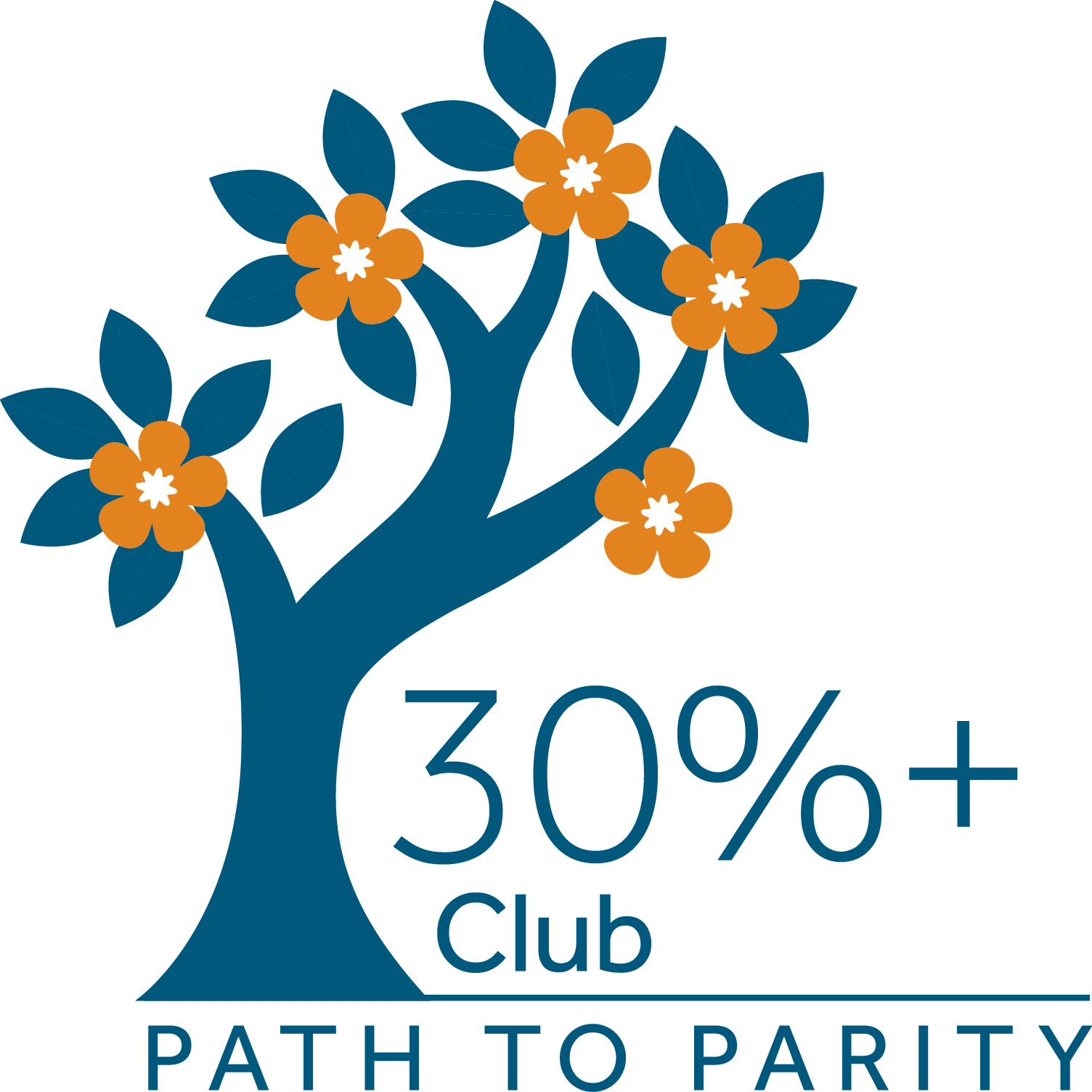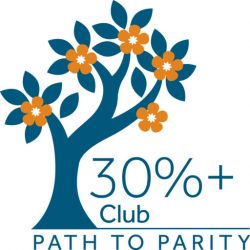Category: All posts
30% Club Malaysia Unveils Mentee Circle

The 30% Club Malaysia through its Board Mentoring Scheme unveiled a mentee networking group, the Mentee Circle.
Interestingly, the idea behind the MenteeCircle came from the graduating mentees themselves, with the goal of building an ecosystem of board ready women.
At the virtual launch earlier today its founding chair Tan Sri Zarinah said the Mentee Circle is a useful forum to enable one to connect and network, to share experiences & learn from each other & to initiate programmes that will enhance one’s visibility as aspiring directors.
The Mentee Circle aims:
-
- To foster connection & collaboration among mentees within the cohort during & post the 9-month mentoring period;
- 2. To promote knowledge sharing through relevant events within the mentee community, as well as with selected mentors & corporate leaders;
- 3. To provide a platform to raise the visibility and enhance the visibility of board-ready candidates.
- The Mentee Circle has lined-up a series of planned activities for this year & all 30% Club Malaysia mentees are invited to participate.
Discussion with Ministry of Women, Family and Community Development
A discussion with YB Hannah Yeoh and her team on the challenges of increasing women representation on the boards of public listed companies and the way forward .
A virtually discussion with Lembaga Tabung Haji
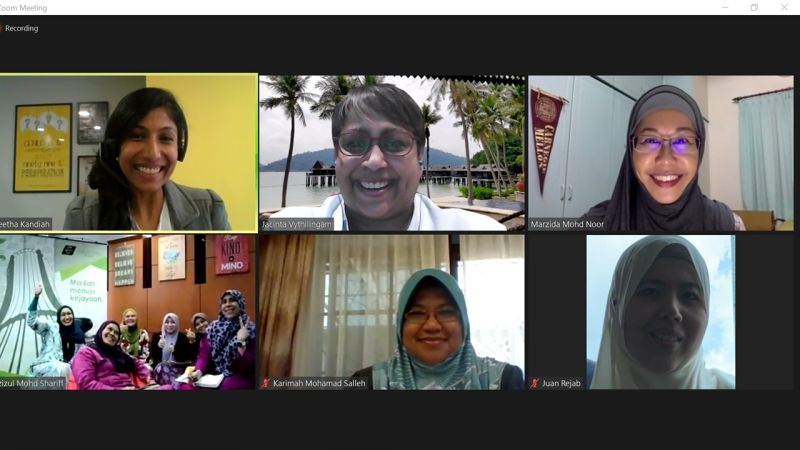
On 15 December, members of the 30% Club’s Activate team virtually met with a very passionate team from Lembaga Tabung Haji(TH) lead by Rina Sarif, its Chief Human Capital Officer.
The meeting is part of the 30% Club’s mission to build an ecosystem of corporations to support our campaign in promoting diversity and inclusion focusing on gender balance on the Malaysian corporate boards and C-Suites.
This will be the first of many engagements in the weeks to come, with this very dynamic team.
Dr Miwa Kato shares her view in ‘Half the Sky’ webinar
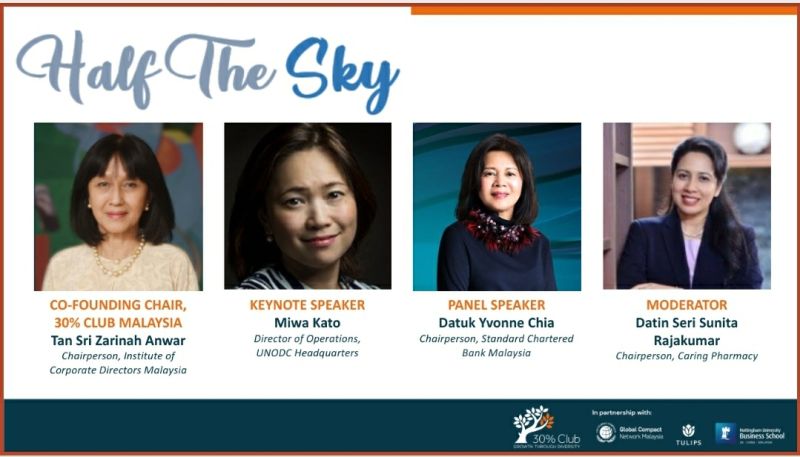
On Dec 11, more than 100 women and men leaders had the privilege to hear from truly remarkable women leaders on the role of women in today’s world at the webinar, Half the Sky.
Dr Miwa Kato – Director of Operations, the United Nations Office on Drugs and Crime, Tan Sri Zarinah – Chairperson, Institute of Corporate Directors Malaysia and Datuk Yvonne Chia – Chairperson, Standard Chartered Bank Malaysia left the audience truly inspired with their thoughts and insights gleaned from a wealth of experience and wisdom of how to embrace opportunities. The session was moderated by Datin Seri Sunita Rajakumar, Chairperson, Caring Pharmacy.
The overwhelmingly positive feedback from the participants in the webinar, who joined from as far as Japan and Africa, was testament to the value that this session brought. The 30% club’s goal was to provide a different perspective and empower the right thinking, which was successfully delivered.
We would like to thank our partners, Global Impact Network Malaysia, TULIPS MOVEMENT and Nottingham University Business School for the collaborative effort in organizing this session.
30% Club Malaysia signs Memoranda of Understanding with MICG, CnetG and ASB
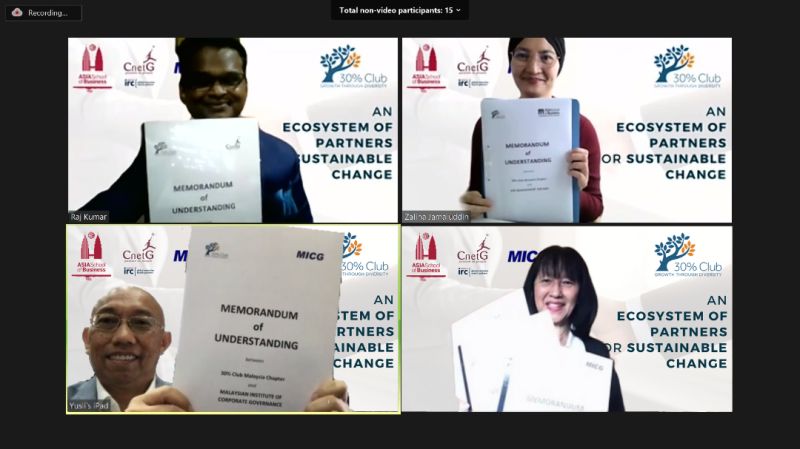
30% Club Malaysia has signed Memoranda of Understanding with the Malaysian Institute of Corporate Governance (MICG), CnetG Asia Sdn Bhd (CnetG), and Asia School of Business (ASB).
These partnerships include the promotion of diverse and inclusive leadership as part of corporate governance advocacy with MICG; access to research and leadership development that support the goal of developing more board-ready women with ASB through its MBA and select Executive Education programmes; and collaboration with CnetG, to develop framework that advances diversity on boards and C-suites with PLCs, multinational companies, universities and professional bodies.
“As the world increasingly works in a collaborative manner, we seek to strategically partner with those who will amplify our goal to increase women representation on boards and senior leadership positions. In 2020, five years on, our focus has been on building a more robust ecosystem aimed at this case for change,” said Tan Sri Zarinah Anwar, Co-Founding Chair, 30% Club Malaysia during a virtual signing ceremony, the first of its kind for this business-led campaign.
30% Club Malaysia Widens Eco-System with New Partners

Three New Partners To Join Forces For Sustainable Change in Malaysian Corporates
Kuala Lumpur, 10 December 2020 – Recently, 30% Club Malaysia has signed Memoranda of Understanding (MoU) with the Malaysian Institute of Corporate Governance (MICG), CnetG Asia Sdn Bhd (CnetG), and Asia School of Business
(ASB) respectively.
This is a positive step in building an ecosystem of partners, moving together towards a common goal – the promotion of diversity, equity and inclusion (DE&I), with a focus on gender balance on Boards and C-Suites, encouraging businesses to work together for change and sustainable progress.
These partnerships will enable 30% Club Malaysia to establish avenues for corporations to gain access to knowledge, insights and best practices in advancing the diversity and inclusion agenda in their organisations.
These would include amongst others the promotion of diverse and inclusive leadership as part of corporate governance advocacy with MICG; access to research and leadership development that support the goal of developing more board-ready women with ASB through its MBA and select Executive Education programmes; and a collaboration with CnetG, to develop framework that advances diversity on boards and C-suites with PLCs, multinational companies, universities and professional bodies.
Professor Charles Fine, President, CEO and Dean of Asia School of Business said, “The partnership between Asia School of Business, in collaboration with MIT Sloan and the Malaysia chapter of the 30% Club is another step in building a holistic and collaborative talent ecosystem in Asia. This relationship allows us to learn and cocreate on key talent development initiatives with the Malaysian and broader regional business community.”
“CnetG Asia is committed to guiding boards and senior management to make effective and inclusive leadership hiring decisions. Our objective is to encourage boards and executive search firms in Malaysia to support principles and best practices in building a diverse and inclusive board and management teams. Executive search firms play a key role in identifying and engaging with a wider pool of talents through their various networks, trust and credibility with executive talents,” said Raj Kumar Paramanathan, Managing Partner, CnetG Asia Sdn Bhd.
He added, “Partnering with 30% Club Malaysia will enhance our efforts to influence and impact by advancing conversations around diversity and inclusion with boards and senior leadership teams.”
Dato’ Yusli bin Mohamed Yusoff, MICG President said, “I am delighted that MICG will be in partnership with the 30% Club Malaysia. MICG looks forward to supporting and empowering more women on their journey towards senior leadership and Board positions. The Institute will support in kind with participation as speakers, contribution of articles and research and opportunities to mentor women as they take on increasing responsibility in their organisations.”
“Since our establishment in 2015, we have been on a journey with key stakeholders to increase the representation of women on the boards of Malaysian public listed companies. Today, we are pleased to welcome Malaysian Institute of Corporate Governance (MICG), CnetG Asia Sdn Bhd and the Asia School of Business into our ecosystem of partners for sustainable change,” said Tan Sri Zarinah Anwar.
She continued, “As the world increasingly works in a collaborative manner, we seek to strategically partner with those who will amplify our goal to increase women representation on boards and senior leadership positions. In 2020, five years on, our focus has been on building a more robust ecosystem aimed at this case for change.”
The 30% Club Malaysia is part of a global campaign led by Chairs and CEOs taking action to increase gender diversity at board and senior management levels. Statistics at the end of 2019 showed women representation on the top 100 public listed companies (PLC) boards rose to 26.9%. There was also no all-male board in the Top 100 PLCs. The percentage today has dipped slightly to 25.4%, believed to be largely attributed to the change in the composition of the Top 100 companies, with several PLCs now in the Top 100 having no women on board.
The 30% Club hopes this is a temporary setback and will continue its efforts to address the gap. Malaysia remains in the lead position amongst its peers in ASEAN as well as some other Asian markets, such as Japan and Hong Kong.
[END]
For media enquiries, please contact:
Norlida Azmi
Media/PR & Communications
Email: comms.30percentclubmalaysia@gmail.com
Inching closer to 30% women on board
Kuala Lumpur, 18 Nov 2020 – The 30% Club Malaysia observes that more organisations in Malaysia have embraced gender diversity on boards, an integral component of good corporate governance.
According to Co-Founding Chair Tan Sri Zarinah Anwar, statistics at the end of 2019 showed women representation on the top 100 public listed companies (PLC) boards rose to 26.9%, almost double what it was in 2015 when the Malaysian chapter of the 30% Club was established. There was also no all-male board in the Top 100 PLCs.
The percentage today has dipped slightly to 25.4%, believed to be largely attributed to the change in the composition of the Top 100 companies, with several PLCs now in the Top 100 having no women on board. The 30% Club hopes this is a temporary setback and will work towards helping to address the gap.
Nevertheless, according to Tan Sri Zarinah, Malaysia remains in lead position amongst our peers in ASEAN; in fact Malaysia ranks second only to Australia in the Asia Pacific region.
Women representation on the boards of all the 900+ PLCs has also steadily increased to 17.2%, an increase of 6.5% from 2015. Tan Sri Zarinah was speaking at a virtual event to celebrate the successful completion of the fifth cohort of the Club’s Board Mentoring Scheme and the on boarding of the sixth yesterday.
The Board Mentoring Scheme, established in collaboration with PwC Malaysia in 2017, aims to accelerate the appointment of more women to company boards by fast tracking their acquisition of competencies and appreciation of the role and expectations of board members from advice and guidance by senior and highly experienced mentors.
Since the launch of the scheme in 2017, 48 women have gone through the 9-month mentoring program and 27% have been appointed to boards of companies.
“The road to achieving 30% women on board has not been easy. The 30% Club Malaysia through its Board Mentoring Scheme has helped to develop a broader pipeline of board-ready women candidates to be considered for board positions,” said PwC Malaysia Partner and 30% Club Malaysia Steering Committee Member Pauline Ho.
“The Board Mentoring Scheme is part of 30% Club Malaysia’s effort to address the gender imbalance at the top of the corporate structure,” she added.
According to Tian Pouw (TP) Pun, a Board Mentoring Scheme working member of the 30% Club Malaysia, the scheme brings together experienced board directors as mentors and aspiring board-ready women under an umbrella with a focus on professional and personal development.
He added that besides gaining clarity, building courage and confidence, participating in this scheme will lead to enhanced leadership capabilities to succeed in a diverse environment in their current workplace.
[END]
For media enquiries, please contact:
Norlida Azmi
Media/PR & Communications
Email: comms.30percentclubmalaysia@gmail.com
Mujeres ocupan 17% de los puestos en las juntas directivas de emisores colombianos
La presidente de mastercard y cochair del Club del 30% explicó que, aunque el país está en el promedio mundial, todavía falta mucho para tener equidad de género en las compañías.
‘Mujeres en juntas directivas es un negocio que vale la pena’
Mónica Contreras, CEO del Club del 30%, habló del reto que tiene el país para subir la participación de las mujeres en esos espacios de 17% a 30%.
https://www.portafolio.co/economia/mujeres-en-juntas-directivas-es-un-negocio-que-vale-la-pena-club-30-por-ciento-546305
